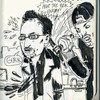Welcome back to Routine Moments in Baseball History, a running weekday feature that looks back at plays that have been ignored by the history books because history books only talk about things that are important or interesting. Today's installment is "Wamby Finds His Calling." August 27, 1915, was a good day for baseball. It was unseasonably chilly for August in Cleveland, and there were fewer than 1,500 people roaming about the empty confines of League Park—the Indians were in sixth place in the American League, a distant 31 games behind the visiting first place Boston Red Sox, and who wanted to see such a lousy set of bums lose in the cold?
Advertisement
If you were Bill Wambsganss, the Indians' second baseman, every day was a good day for baseball. The team had sold Nap Lajoie, Wambsganss's idol, to the Philadelphia Athletics, and he replaced his hero at second to start the season. He could never fill Lajoie's shoes (the man meant so much to the team that they were renamed the Naps until he left), but he was a very good player in his own right. He hadn't yet figured out how to hit pitching at that level—he was batting just .200 entering the game—but he was a smooth fielder right from the start, tall and somewhat gawky but oddly graceful, roaming all over the space behind the pitcher's mound to retrieve balls and forming one half of a truly great double play combination with shortstop Ray Chapman. If you were a baseball obsessive in Cleveland you might have gone to the ballpark as often as you could just to see the two young talented infielders flip the ball to each other. (If you were a baseball obsessive in Cleveland in 1915, there wouldn't have been much for you to watch.)Wambsganss is one of those players who is the answer to a trivia question thanks to his unassisted triple play in the 1920 World Series (the trivia question being, "Who is the only player to record an unassisted triple play in the World Series?") but he was a great fielder who improved as a hitter over the course of his 13-year career and had to deal with the loss of his friend and teammate when Chapman got killed by a pitch from Carl Mays. But all that was ahead of him in 1915. In the game against the Red Sox, he was a barely-out-of-the-minors 21-year-old kid still adjusting to the experience of playing in the hallowed ground of big-league ballparks. Just a couple years before he had been in the seminary studying to be a Lutheran minister like his father, but he found his true calling on the baseball field and his dad told him to go for it, son: Ditch the cloth and get thee to a baseball diamond.That's a more friendly, encouraging attitude than we might expect from a turn-of-the-century Lutheran clergyman, but maybe Wambsganns's father knew the power and joy of finding the single thing that you were put on the earth to do. For him, it was saving souls from hellfire. For his son, it was saving balls from becoming hits—and who are we, simple creatures who eat and defecate for a few decades before returning to dust, to decide that one is more important or nobler than the other? For his part, Bill never looked back and instead fell into the pleasant equanimity of a man who's doing the job he was made for. When people complained that it was hard to put his tongue-twister of a name on scoreboards and box scores, he shrugged and let them call him "Wamby." Just before he tagged the runner out in the 1920 World Series for the third out of his triple play, the Brooklyn Robin reportedly asked him, "Where'd you get that ball?" "Well, I've got it and you're out number three," he replied. He saw on a lot in his time on the field—he witnessed a death, he became a celebrity after that triple play, he had great days and terrible ones—but there's no question there was nowhere he'd rather be. He played until he couldn't play anymore, then he coached minor league baseball and for a short-lived indoor baseball league and the All-American Girls Professional Baseball League. He lived his life on a series of baseball diamonds, and by all accounts it was a long and rewarding one. That cold game against the Red Sox (which the Indians won 4-3), was just a beginning.A lot of details were taken from this excellent biographical sketch of Bill Wambsganns.This has been Routine Moments in Baseball History. Follow Harry Cheadle on Twitter.
